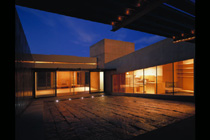Topic: Architecture / Travel
 Today architect Antoine Predock gave a lecture at the Art Institute of Chicago organized by the museum's Architecture and Design Society. And TAKOTRON was there. The architect spoke mostly of his more recent projects, including two proposals that recently won their respective competitions: The National Palace Museum in Taipei, Taiwan (below), and The Canadian Museum for Human Rights in Winnepeg.
Today architect Antoine Predock gave a lecture at the Art Institute of Chicago organized by the museum's Architecture and Design Society. And TAKOTRON was there. The architect spoke mostly of his more recent projects, including two proposals that recently won their respective competitions: The National Palace Museum in Taipei, Taiwan (below), and The Canadian Museum for Human Rights in Winnepeg. If you're not familiar with Predock's work, it would help to generally think of it as fitting nicely into Kenenth Frampton's outline of Critical Regionalism. Let's bust out that old book (The Anti-Aesthetic, ed. Hal Foster, 1983) for some good quotes from the classic "Towards a Critical Regionalism":
Architecture can only be sustained today as a critical practice if it assumes an arriere-garde position, that is to say, one which distances itself equally from the Enlightenment myth of progress and from a reactionary, unrealistic impulse to return to the architectonic forms of the preindustrial past. [...] The fundamental strategy of Critical Regionalism is to mediate the impact of universal civilization with elements derived indirectly from the peculiarities of a particular place. (22-3)
Much of Predock's work is in the Southwest U.S. (his firm's office is in Albequerque) where it makes use of local materials and imagery from the inspirational landscapes and their indigenous cultures. He succeeds in creating powerful and resonant spaces while avoiding the pitfalls Frampton warns against, namely "nostalgic historicism or the glibly decorative" and "the communicative or instrumental sign."
Predock's Shadow House in Santa Fe (above) is built to frame views of the nearby Jemez mountains as it resonates with the desert sun through the use of an edge-lit glass prism and courtyard enclosed by two walls that incorporate copper.
 Predock accepts the Critical Regionalist label to a degree, but is careful not to be confined by it. He reponds to the idea, "yeah, but it's portable." The National Palace Museum in Taiwan indirectly references a plethora of cultural symbols and ideas, including the distant peak of "Jade Mountain," early scroll paintings depicting rivers and mountains, and lanterns, as well as borrowed "pan-asian" examples, especially for the surrounding gardens. It is approached from two opposite paths that bridge a surrounding canal. The paths are to remain open after hours, so that pedestrians can travel through the space without actually entering the building. The museum is to house some 650,000 treasures secretely salvaged from mainland China's Forbidden City by Chiang Kai-shek, in addition to contemporary artwork and performance spaces and increasing collections of pieces from other Asian countries.
Predock accepts the Critical Regionalist label to a degree, but is careful not to be confined by it. He reponds to the idea, "yeah, but it's portable." The National Palace Museum in Taiwan indirectly references a plethora of cultural symbols and ideas, including the distant peak of "Jade Mountain," early scroll paintings depicting rivers and mountains, and lanterns, as well as borrowed "pan-asian" examples, especially for the surrounding gardens. It is approached from two opposite paths that bridge a surrounding canal. The paths are to remain open after hours, so that pedestrians can travel through the space without actually entering the building. The museum is to house some 650,000 treasures secretely salvaged from mainland China's Forbidden City by Chiang Kai-shek, in addition to contemporary artwork and performance spaces and increasing collections of pieces from other Asian countries.At the end of the lecture the architect took some questions. I posed an architectural problem I had been thinking about for a while. So you know I represent Long Island, but not a setting of beachfronts overlooking the Sound or nice little towns where you can get good seafood and take the old boat out. I grew up between two commercial highways lined with gas stations and strip malls. There's no train station in my town, but from one a town over it's an hour ride to Manhattan. So my setting was nothing special, nothing too nice. I'm not ashamed, and when away for awhile I even find myself feeling just a little bit of home pride. This is all only slightly relevant, and I certainly didn't bring it up tonight. You can read more about my town on the Takotron images page. What I asked, was something like, "is there a way to build a project that resonates with its setting if the setting is a place that's quotidian and anonymous, like some of our overdeveloped suburbs?" Mr. Predock gave an informed, deep, helpful response (I must paraphrase):
In such a situation (and others as well) it helps to think on archaological time. When you look at a roadcut, you see the layers of different eras, and on the top is a thin section of candy bar wrappers and cans and things. So, on this scale it is possible to think of things like suburban developments as a temporary fluttering. Most of our country is now covered like this, but in a way it is only temporary. We live in a place built on genocide, but underneath are rich layers of different cultures and the real essence of the land. So sometimes, especially in a situation like that, you need to look beyond the scatterings on the surface, to somewhere deeper.
FOR MORE: www.predock.com
Posted by thenovakids
at 10:06 PM CDT
Updated: Tuesday, 30 May 2006 12:32 AM CDT
Post Comment | Permalink | Share This Post
Updated: Tuesday, 30 May 2006 12:32 AM CDT
Post Comment | Permalink | Share This Post